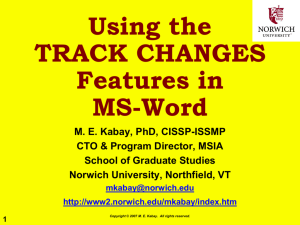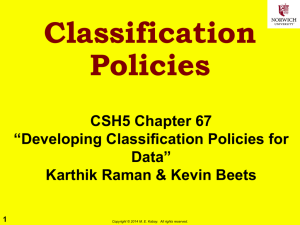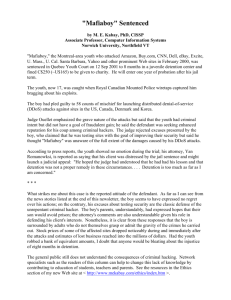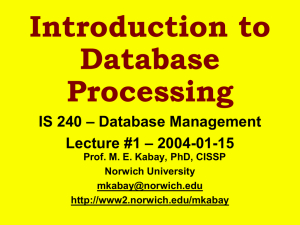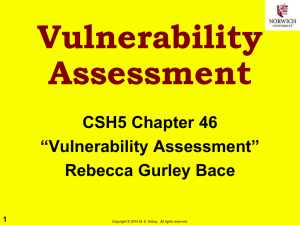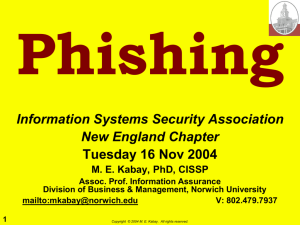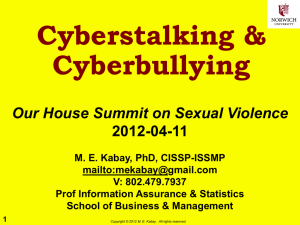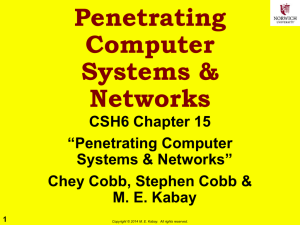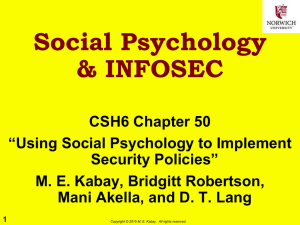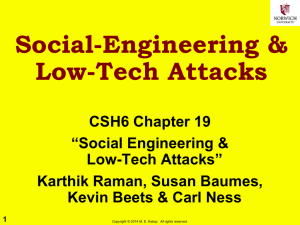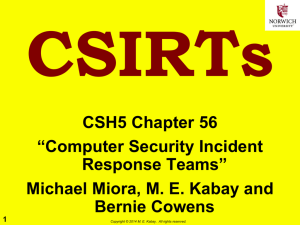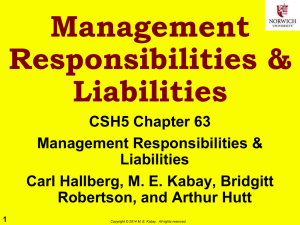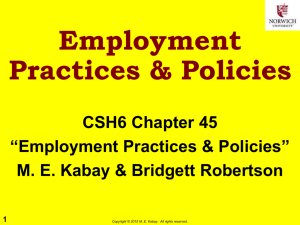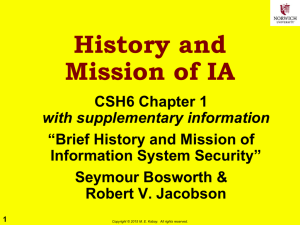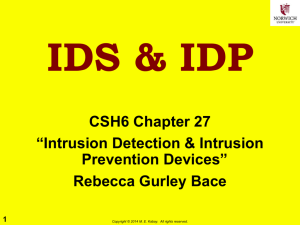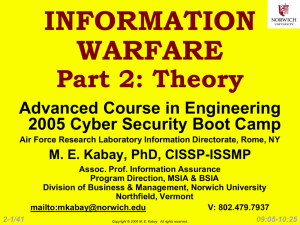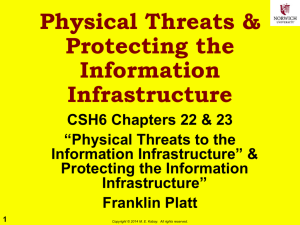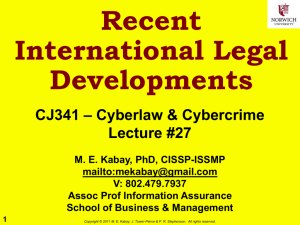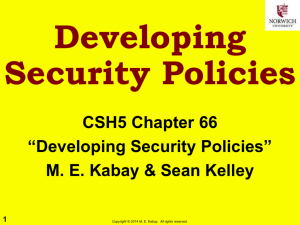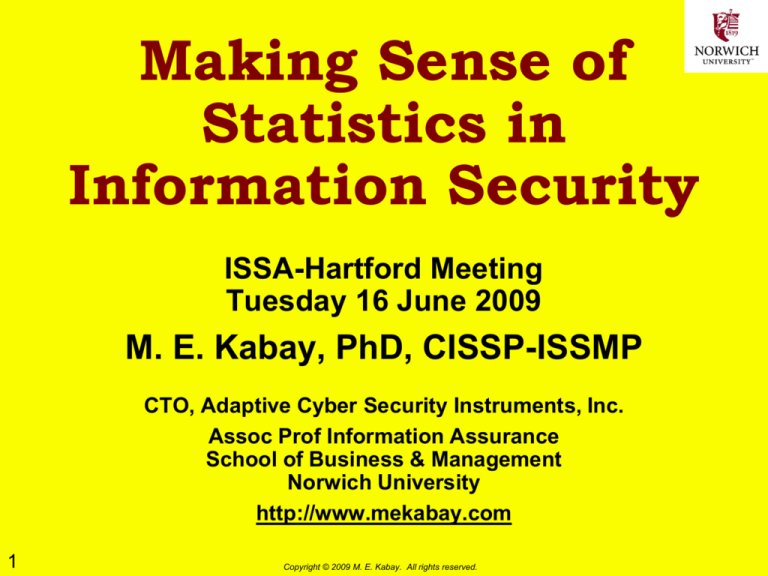
Making Sense of
Statistics in
Information Security
ISSA-Hartford Meeting
Tuesday 16 June 2009
M. E. Kabay, PhD, CISSP-ISSMP
CTO, Adaptive Cyber Security Instruments, Inc.
Assoc Prof Information Assurance
School of Business & Management
Norwich University
http://www.mekabay.com
1
Copyright © 2009 M. E. Kabay. All rights reserved.
Topics
Introduction
Fundamentals of Statistical Design and
Analysis
Resources for Further Study
2
Copyright © 2009 M. E. Kabay. All rights reserved.
Introduction
Professional Background in Applied Statistics
Value of Statistical Knowledge Base
Limitations on Our Knowledge of Computer
Crime
Limitations on Applicability of ComputerCrime Statistics
3
Copyright © 2009 M. E. Kabay. All rights reserved.
Professional Background in
Applied Statistics
Studied biology, genetics at McGill 1966-1970
Fascinated by biometrics (statistics applied to
biological research) taught by Prof Hugh Tyson
1969 using Sokal & Rohlf’s Biometry text
Continued study independently during MSc at
McGill in teratology 1970-1972
Took PhD Dartmouth in invertebrate zoology &
applied statistics 1972-1976;
One of PhD examiners was Dr Thomas E.
Kurtz, co-inventor of BASIC (and a
statistician)
Have taught applied statistics at universities
since 1975 & served as statistical consultant to
scientists and industry
4
Copyright © 2009 M. E. Kabay. All rights reserved.
Value of Statistical
Knowledge Base
Security professionals often asked about
Frequency and security breaches
Severity of damage
Bear upon risk management
Quantitative
Qualitative
Competitive analysis
Litigation
Standards of due care and diligence
Commonly-accepted or best practices
5
Copyright © 2009 M. E. Kabay. All rights reserved.
Limitations on Knowledge of
Computer Crime: Detection
AKA problem of ascertainment
Not always possible to detect breach of
security
E.g., data leakage using covert channel has
no record and no evidence (until competitor
steals the market)
But DoD DISA research 1995-1996 showed
experimental evidence of non-detection
68,000 non-classified DoD systems
Penetration tests broke into 2/3 of them
Only 4% of sysadmins noticed
penetrations
6
Copyright © 2009 M. E. Kabay. All rights reserved.
Limitations on Knowledge of
Computer Crime: Reporting
Few reported in systematic way
Unquantified, anecdotal reports of
information assurance specialists
Only ~10% of all breaches known publicly
DoD DISA studies support this view
Only ~½% of all detected breaches were
properly reported as required by
procedures
“… COMPUTER CRIME STATISTICS SHOULD
GENERALLY BE TREATED WITH
SKEPTICISM.”
7
Copyright © 2009 M. E. Kabay. All rights reserved.
Limitations on Applicability of
Computer-Crime Statistics
Enormous variability in computer systems and
networks
Processors
Operating systems
Topologies
Firewalls
Encryption
Applications
…
How do we generalize from specific cases?
How do we build database of usable statistics?
8
Copyright © 2009 M. E. Kabay. All rights reserved.
Fundamentals of Statistical
Design and Analysis
Descriptive Statistics
Inference
Hypothesis Testing
Random Sampling
Confidence Limits
Contingency Tables
Association vs Causality
Control Groups
Confounded Variables
9
Copyright © 2009 M. E. Kabay. All rights reserved.
Descriptive Statistics (1)
Presentation of data can greatly influence
perception of reality
Amateurs (e.g., some reporters and PR
personnel) can inadvertently or deliberately
distort information through elementary
mistakes
E.g., consider 3 companies who report
following losses from security breaches:
$1M
Next page shows different ways
$2M
of representing these data
$6M
10
Copyright © 2009 M. E. Kabay. All rights reserved.
Descriptive Statistics (2)
Class
Frequency
Class
Frequency
≤ $2M
2
< $1M
0
> $2M
1
≥ $1M & < $2M
1
≥ $2M & < $3M
Left-hand table:
≥ $3M & < $4M
Wrong impression of
≥ $4M & < $5M
where the data lie
≥ $5M & < $6M
No sense of lower or
≥ $6M & < $7M
upper bounds
≥ $7M
No idea of gap
Right-hand table:
between 1, 2 & 6
Still wrong mean
Cannot compute
mean, median at all
11
Copyright © 2009 M. E. Kabay. All rights reserved.
1
0
0
0
1
0
Descriptive Statistics (3)
Measures of central tendency
Mean (computed) – sum / total number
Median (counted) – value of middle of sorted
list
May differ if distribution is skewed
(asymmetric)
12
Copyright © 2009 M. E. Kabay. All rights reserved.
Descriptive Statistics (4)
Measures of dispersion (variability)
Range – largest value – smallest value
Variance – average of squared deviations
from mean (σ2)
Standard deviation – square root of variance
(σ)
In a Gaussian (“Normal”)
frequency distribution,
standard deviation is
distance between mean
& inflection point of curve
(where slope stops increasing)
13
Copyright © 2009 M. E. Kabay. All rights reserved.
Inference (1)
Population is entire set of all possible
members
E.g., population of residents of USA is all
people residing in USA at a specific time
Sample statistic is known as parametric
value
Sample is enumerated or measured set of
observations
E.g., 100,000 people selected from US
population is a sample
Statistic computed on sample is sample
statistic or estimator of parametric value
14
Copyright © 2009 M. E. Kabay. All rights reserved.
Inference (2)
Statisticians try to infer population statistics
from sample statistics
Called statistical inference
E.g., population mean is µ and sample
mean is ; parametric variance is 2 and
sample is s2
Sample statistics sometimes have different
formula from parametric statistic
E.g., estimates µ
But estimator s2 of 2 is sum of squared
deviations from mean divided by (n-1)
instead of by n [where n is sample size]
15
Copyright © 2009 M. E. Kabay. All rights reserved.
Hypothesis Testing (1)
Often need to test an idea (hypothesis) about
populations based on sample statistics; e.g.,
Testing idea that µ lies between 1.3 & 4.3
based on a sample mean = 2.8
Testing idea that σ ≤ 35.6 based on s = 52.8
Can also test hypotheses about relationships
E.g., given observed
Penetration
data in table, test
Firewalls No
Yes
Totals
idea that firewalls
and penetration
No
25
75
100
16
Yes
70
130
200
Totals
95
205
300
Copyright © 2009 M. E. Kabay. All rights reserved.
Hypothesis Testing (2)
Null hypothesis (H0) is that there is no relationship
Testing for relation between two independent variables
Presence of firewall
Detection of penetration
Various calculations available to test for independence;
e.g.,
Chi-square 2
Log-likelihood ratio G
Penetration
Both are 0 in a population
where there is no relationship
Firewalls No
Yes
Totals
between variables
No
25
75
100
Compute probability that
sample statistic would occur Yes
70
130
200
by chance alone if really 0
Totals
95
205
300
in population
17
Copyright © 2009 M. E. Kabay. All rights reserved.
Hypothesis Testing (3)
Probability that the null hypothesis is true
p(H0) > 0.05:
not statistically significant (symbols ns)
0.05 p(H0) > 0.01:
statistically significant (*)
0.01 p(H0) > 0.001:
highly statistically significant (**)
p(H0) 0.001:
extremely statistically significant (***).
18
Copyright © 2009 M. E. Kabay. All rights reserved.
Random Sampling (1)
Randomization essential to all of statistical
inference
Sample is random when every member of
population has equal likelihood of being selected
for sample
Non-random sample is biased
E.g., population is all members of
multinational company BUT most employees
picked are disproportionately from US
subsidiaries – biased toward US sub-group
E.g., population is all adult US residents but
2x as many men are selected as women –
gender bias
19
Copyright © 2009 M. E. Kabay. All rights reserved.
Random Sampling (2)
Surveys can suffer from response bias
What if survey is known only to a subset of
desired population?
What if results report only those who
respond?
What if those who respond are different
from those who do not respond?
The response bias can confound variables:
Subjects of the questions are confounded
with
Awareness of the survey
Tendency to respond
20
Copyright © 2009 M. E. Kabay. All rights reserved.
Confidence Limits (1)
Point estimates not generally useful
The average salary was $38,232
The cost of gasoline rose $0.12 per week last quarter
Generally prefer to have a sense of reliability
Often report mean ± standard deviation
The average salary was $38,232 ± $1955
The cost of gasoline rose $0.12 ± $0.035 per week
last quarter
Should specify sample size to give intuitive sense of
reliability
The average salary was $38,232 ± $1955 (n = 12)
The average salary was $38,232 ± $1955 (n = 12,000)
21
Copyright © 2009 M. E. Kabay. All rights reserved.
Confidence Limits (2)
Can compute ranges that have a known probability
of including the parametric value being estimated:
The probability that the average salary was
between $36,277 & $40,187 based on the sample
SAME
statistics is 95%.
The 95% confidence limits of the average salary
were $36,277 & $40,187
Confidence limit computations depend on
Random sampling
Known error distribution (e.g., Normal/Gaussian)
Equal variances at all values
Larger values no more variable than smaller
values
22
Copyright © 2009 M. E. Kabay. All rights reserved.
Contingency Tables
Contingency tables present counted
(enumerated) data for two or more variables
Common error: Presenting only part of
contingency table
“Over 70% of systems without firewalls
were penetrated last year”
Yes, but what % of systems with firewalls
were penetrated?
23
Copyright © 2009 M. E. Kabay. All rights reserved.
Association vs Causality
Don’t mistake association for causality
Error of logic known as post hoc, ergo
propter hoc – after the fact, thus because of
the fact
E.g., suppose study shows that
organizations with lots of fire extinguishers
have lower rate of computer network
penetration than those with few fire
extinguishers
Do we conclude that presence of fire
extinguishers causes better resistance to
penetration?
Many possible explanations for association
other than causality
24
Copyright © 2009 M. E. Kabay. All rights reserved.
Control Groups
When associated variables may be
confounded, one can control for the variables
E.g., in fire-extinguisher case
Measure state of security awareness
Compare groups with similar level of
awareness
Statistical techniques exist to control for
independent variables and their interactions
Analysis of variance with regression
Multivariate analysis of contingency tables
25
Copyright © 2009 M. E. Kabay. All rights reserved.
More about Confounded
Variables
“One in 10 employees admitted stealing data or
corporate devices, selling them for a profit, or knowing
fellow employees who did.”
Confounds
Theft of data
Theft of devices
Selling things for profit
Knowing of others who did such criminal acts
Cannot tease out the individual contributions
“Knowing” particularly bad: confounds occurrence with
social networking
If everyone knows everyone’s business, could have
100% +ve response even if only 1% were criminals
26
Copyright © 2009 M. E. Kabay. All rights reserved.
For Further Reading
Kabay, M. E. (2009). Understanding Studies
and Surveys of Computer Crime:
http://www.mekabay.com/methodology/crime_stats_methods.pdf
(the apparent blanks are the underscore character, _ )
http://www.mekabay.com/methodology/crime_stats_methods.htm
Any introductory text for applied statistics in
the social sciences
Any introductory text on survey design and
analysis
27
Copyright © 2009 M. E. Kabay. All rights reserved.
Sample Textbooks
Babbie, E. R., F. S. Halley & J. Zaino (2003).
Adventures in Social Research : Data
Analysis Using SPSS 11.0/11.5 for Windows,
5th Ed. Pine Science Press (ISBN 0-761-987584).
Sirkin, R. M. (2005). Statistics for the Social
Sciences, 3rd Ed. Sage Publications (ISBN 1412-90546-X).
Schutt, R. K. (2003). Investigating the Social
World: The Process and Practice of Research,
Fourth Edition. Pine Science Press (0-76192928-2).
28
Copyright © 2009 M. E. Kabay. All rights reserved.
Sample Web Sites
Creative Research Systems “Survey Design”
http://www.surveysystem.com/sdesign.htm
New York University “Statistics & Social
Science” http://www.nyu.edu/its/socsci/statistics.html
StatPac “Survey & Questionnaire Design”
http://www.statpac.com/surveys/
University of Miami Libraries “Research
Methods in the Social Sciences: An Internet
Resource List”
http://www.library.miami.edu/netguides/psymeth.html
29
Copyright © 2009 M. E. Kabay. All rights reserved.
Discussion
30
Copyright © 2009 M. E. Kabay. All rights reserved.

